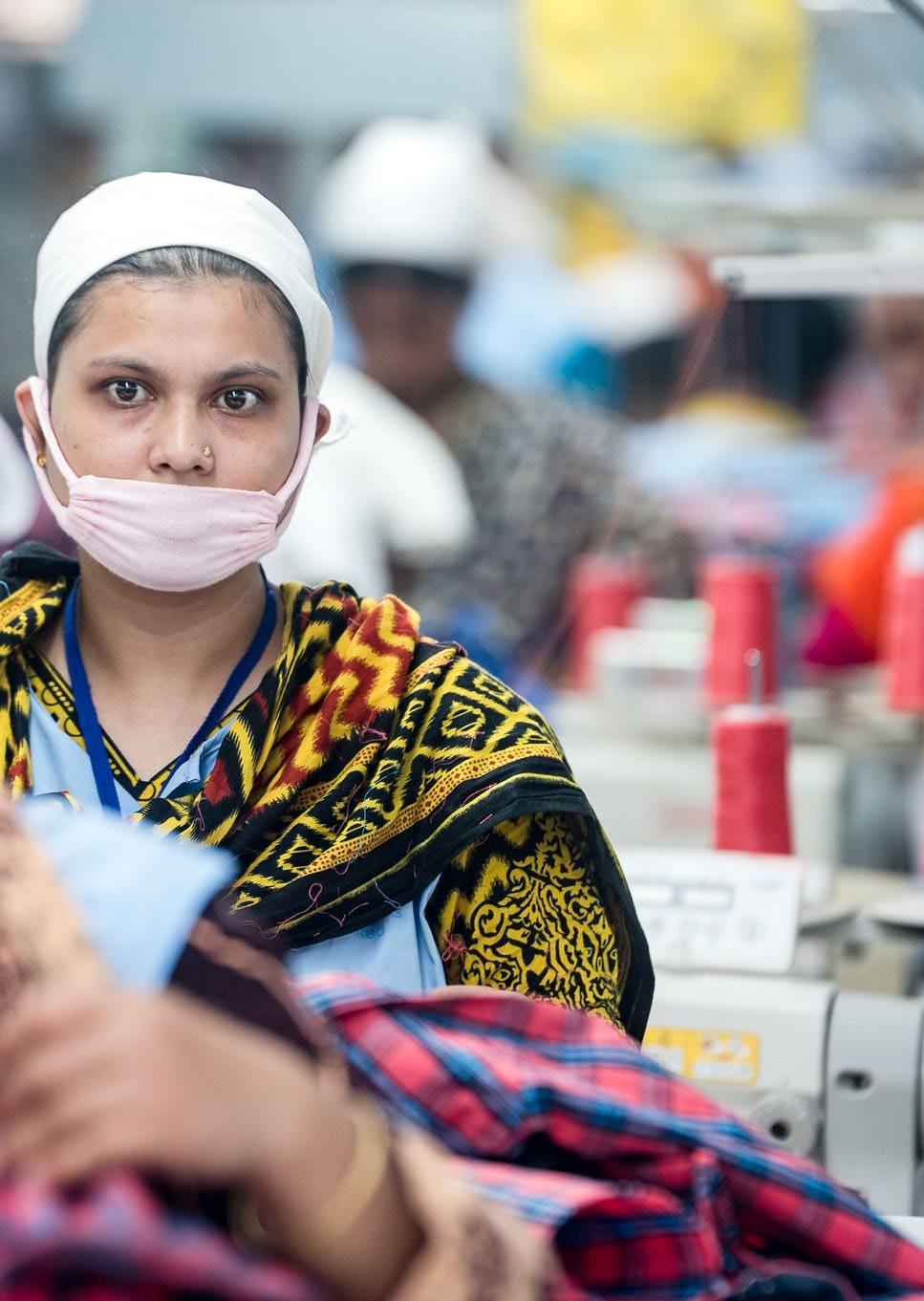is keeping her in poverty


is keeping her in poverty


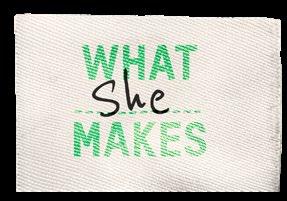

Campaign Brief

August 2021
 On the cover: Garment worker Shima photographed on her home sewing machine in Dhaka. Credit: Fabeha Monir/ Oxfam
On the cover: Garment worker Shima photographed on her home sewing machine in Dhaka. Credit: Fabeha Monir/ Oxfam
The global fashion industry is powered by women who make our clothes. While they make poverty wages, predominantly white male company executives amass mountains of wealth. It is time garment workers were paid a living wage. The What She Makes campaign is calling on Canadian fashion brands to pay a living wage to the garment workers in their supply chains and uphold international labour rights. The time is now to ensure the women who make our clothes can live dignified lives.
 Fabeha Monir / Oxfam
Fabeha Monir / Oxfam
The fashion industry is huge and glamourous, but it is built on the backs of millions of women who live in poverty despite working countless hours making the clothes we wear. Canadian clothing brands take part in the systemic exploitation of workers by allowing poverty wages to be paid in many of their supplier factories. Canadian brands have a responsibility to pay enough for workers to live on — a living wage. The women who make our clothes are paid such paltry wages — as little as 60 cents per hour in countries like Bangladesh — that they live in dismal conditions, fall into spiraling debt, and cannot afford the healthcare and education they and their families need.1 They are paid less than half what they need to live a decent life. Despite their hard work, the women are trapped in a cycle of poverty. Access to dignified work is a human right and a fundamental pathway out of poverty. Big clothing brands have the power to lift millions of women out of poverty. Decent work on a living wage is essential for the dignity of the millions of people making our clothes. Canadian brands must commit to paying a living wage to the women who make our clothes.
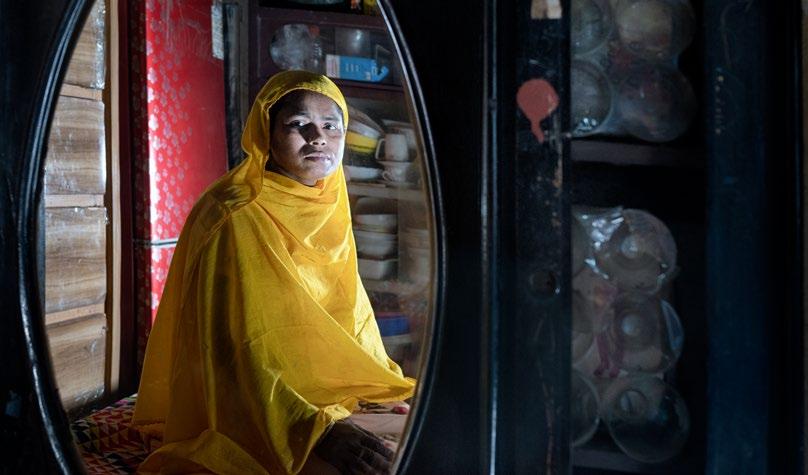
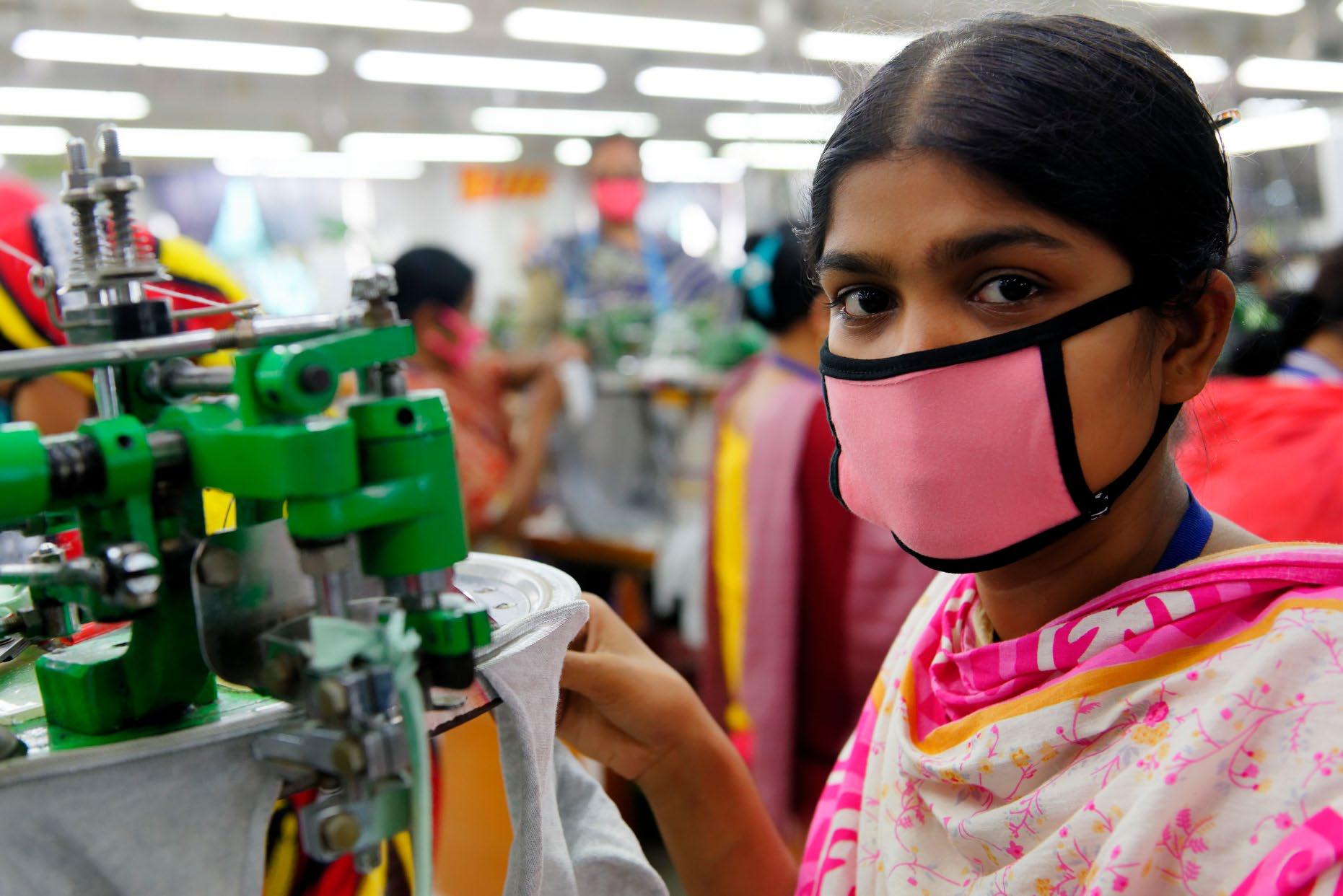 Sima, now 35 years old, began working in the textile industry in Bangladesh at the age of 15. Despite constant work, she has no savings and struggles to pay rent each month.
Credit: Fabeha Monir / Oxfam
A Bangladeshi garment worker is seen wearing a face mask while producing clothing to be sold on major overseas markets. Credit: Marcel Crozet / ILO
Sima, now 35 years old, began working in the textile industry in Bangladesh at the age of 15. Despite constant work, she has no savings and struggles to pay rent each month.
Credit: Fabeha Monir / Oxfam
A Bangladeshi garment worker is seen wearing a face mask while producing clothing to be sold on major overseas markets. Credit: Marcel Crozet / ILO
The women who make our clothes don’t make enough to live on. No matter how hard they work, they can’t work their way to a better life — the wages are just too low. Women make up 80% of the garment industry’s workforce and face a high level of discrimination and harassment.2 The gendered division of work is clearly visible, with women disproportionately concentrated in the lowest paid roles and rarely reaching senior positions. Within the factory, men hold higher paid roles wielding more authority and power.
Maleka Banu, age 45, has worked in Bangladesh’s garment sector for three decades. She began as a helper in a small subcontracting factory that employed 50 people. She now works as a senior
operator at a top-tier garment factory producing for some of the world’s biggest brands, including a Canadian retailer.3,4 She says that, although a lot has changed since she first started working at the age of 14, one thing that has remained constant is the struggle to pull through her daily life. She told Oxfam: “You work, and you work, 6 days a week, 12- to 15-hour shifts, thinking your luck will change. You’ll make it in the end. But the end of my career is already here, I can feel it in the way my supervisors react to my slow and aging body. When will my fortune change? Thirty years, and I still constantly worry about when I will get the next paycheque, whether I will have enough money this month to buy some beef or chicken for my children, whether I have to end my son’s education and put him to work, how I will pay for my mother if she needs to be taken to the hospital for her heart… Now with the coronavirus, I am in constant anxiety over losing my job. I have no savings. At my age, no one will hire me again.”

Taslima, a 21-year-old garment factory worker, says, “It’s been a year since I could […] go home [to] my village. After paying my bills, I cannot save $25 [in] bus fare for a round trip [ticket] to my village. I miss my parents and think about them every day. Because of my job at the garment factory, I can provide for my parents, and it saved me from child marriage, but I cannot live like a human being with the little money I earn. I live in a room with only one window, which has been sealed permanently by the owner because I am single and there are security issues in the slum. I live in the dark at night and feel suffocated in this tiny room, but I cannot do anything. I do not have any support to rent a good room with proper ventilation.”
Women who make our clothes are not paid enough to live a decent life, always running out of money before the end of the month. The meagre wages paid by big brands leave workers malnourished. In a 2019 study of nearly 400 workers in Bangladesh, 91% reported that they cannot afford enough food.5 In order to feed their families, workers purchase food on credit each month, pushing themselves further into a cycle of debt.
Women in the garment sector are often the sole income earners for their households, supporting their parents, spouses and children. In addition to the hours they work at the factory, women also perform most of the unpaid labour at home. Many women are from rural areas and are forced to move to major cities in search of work. Tania, a sewing operator in Dhaka, is one of the 33% of workers in Bangladesh who do not live with their children because of either insufficient income or childcare. She says, “I feel so miserable being a mother; I can’t meet my child. My daughter cries without me.”6 Tania sends most of her income to her parents who care for her child. She only sees her daughter twice per year, during national holidays. Even if she wanted to visit more often, it’s a gruelling 250-kilometer journey which is financially unattainable.
On the factory floor, the working conditions are terrible. With the workers working excessively long shifts, reports of fainting, feeling dizzy and not being allowed to drink water to save time are common. By law, working overtime is voluntary, but, in reality, employers often pressure workers to accept extra hours to deliver orders with short deadlines. Also, workers do not really have the option to say no to overtime — with wages so low,
the overtime stretches their paycheque a bit further. Overtime can be announced without notice making arranging childcare impossible. The long hours of work without breaks takes its toll on the workers’ bodies, with many experiencing injuries and pain. Most workers need to take sick leave but feel they cannot risk missing a day’s work.7 Furthermore, research conducted by ActionAid found a shocking 80% of garment workers in Bangladesh have either seen or directly experienced sexual violence or harassment in the workplace.8
Away from the factory, women’s lives are not easier. The living conditions in the concrete apartments or tin and wood shacks where workers live are crowded, rundown and leak when it rains. The homes share a water source (a tap or tube well) and a cooking area, and many families share a single toilet.9 Rita, a helper in a factory near Dhaka, lives in a tiny, stuffy room only big enough for a bed and a small shelf. Her room is next to the communal cooking area and not far from the open rubbish dump, forcing her to keep the window shut to avoid the stench and smoke. Other women live in similar overcrowded conditions, often with whole families or several workers sharing a room, forcing some people to sleep on the floor.
That millions of women like Maleka, Taslima, Tania and Rita work so hard for so many hours in factories and still come home to shocking poverty conditions is an injustice that needs to be rectified.
Just like many people in Canada lost their jobs due to the economic downturn of the COVID-19 pandemic, internationally the women who make our clothes faced a similar story of mass job loss. With the demand for new clothes plummeting and stores shuttered in the early months of the pandemic, clothing brands abruptly cancelled orders from factories and refused to pay for orders of clothes already completed. As a result, supplier factories in Bangladesh and other sourcing countries, which operate on paper-thin margins, were unable to pay workers’ salaries.
Big fashion brands effectively abandoned workers in their supply chains, leaving them without any means to support themselves or their families. In April 2020, more than a million workers in Bangladesh were fired or laid off.10
they returned to the reopened factories, the women who make our clothes faced the risk of contracting COVID-19 at work — social distancing being impossible on crowded factory floors. It was a bleak choice between starvation or disease.

The world’s 2,153 billionaires have more wealth than 4.6 billion people combined.13 This wealth inequality is starkly illustrated in the garment sector where a privileged few amass vast wealth while millions are trapped in poverty. Clothing brands’ Chief Executive Officers continue to take home massive compensation packages and shareholders see their profits grow, while women toiling in faraway factories are forced into debt to survive.
Already vulnerable from receiving poverty wages for years, workers — with no savings and who still needed to feed their families and possibly cover unforeseen health expenses — were facing an enormous burden.12 This devastating crisis shows the absolute necessity for a living wage. Also, as
Executive pay at the top end of the scale is skyrocketing. Top executives of Canadian fashion brands are paid $18,562 per day, on average, while the women making clothes in Asia earn as little as $5 per day.14 Given this huge disparity, it takes just over four days for a CEO, on average, to earn what an ordinary Bangladeshi woman worker earns in her whole lifetime.15
“The companies who profit [from] these workers in the [garment] production countries… just left us behind to [starve],”
Kalpona Akter, former garment worker and now worker rights activist at Bangladesh Center for Workers’ Solidarity.11
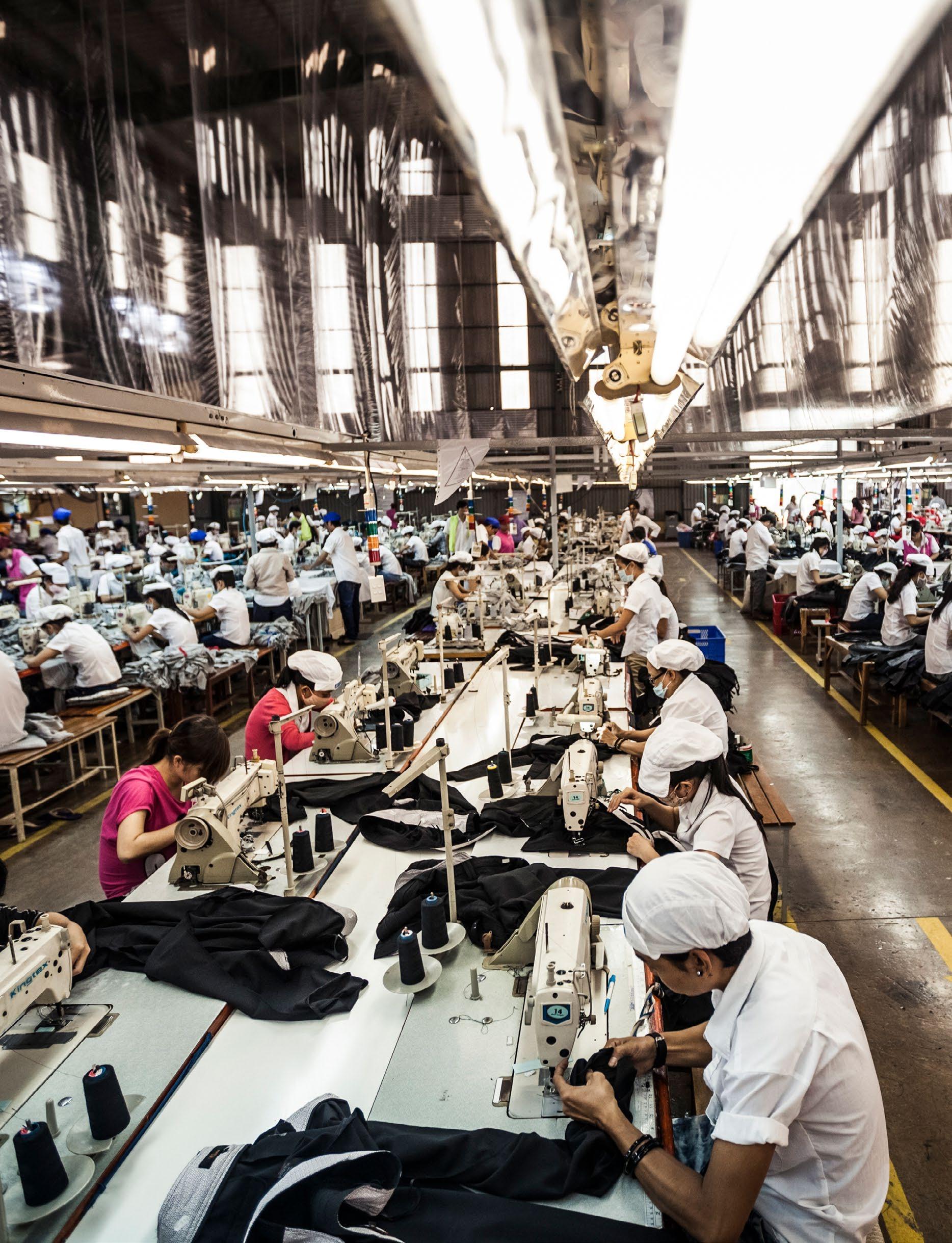
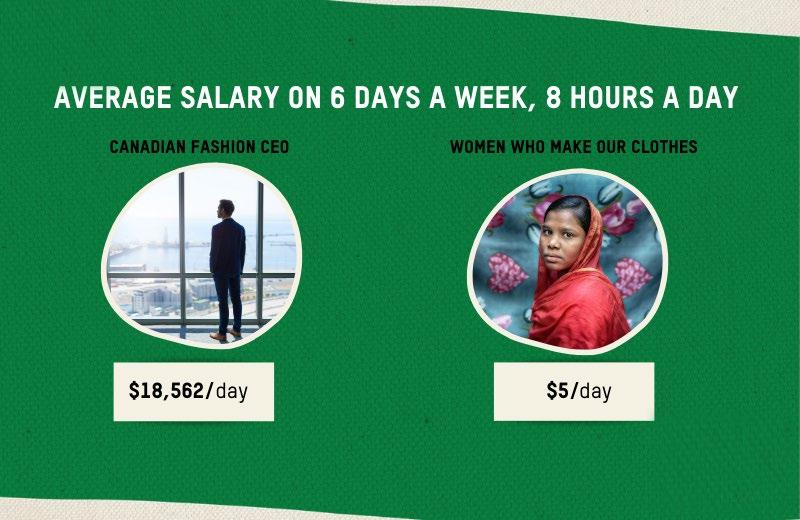
This shocking inequality is the result of deliberate choices by company leadership and shareholders, and governments around the world — choices that have enabled the very wealthy to accumulate more and more, while hundreds of millions remain left behind, unable to rise out of poverty. A living wage for the world’s workers, including the women who make our clothes, is fundamental to ending the inequality crisis.16
In many countries the minimum wage is set at a level that does not correspond with the cost of living. What’s more, workers often take home less than minimum wage, as their line managers illegally deduct wages as a penalty for failing to reach unrealistic production targets. In Bangladesh, 56% of workers reported they regularly had their wages docked for mistakes, refusing to do overtime or failing to meet (impossible) targets, and 43% reported that their working hours were inaccurately calculated.17
The minimum wage in Bangladesh is just 60 cents per hour for the lowest paid worker. That’s less than $5 per day. The last minimum wage increase in Bangladesh was in December 2018, taking the monthly wage to C$120, (8000 Bangladesh taka),18 but this was the first increase since 2013. With the cost of living rising while wages stagnated for that five-year period, the increase made very little difference in the lives of the women who make our clothes.
In Bangladesh, $4.80 per day is not enough to live on. More than 90% of women workers report that they are unable to afford enough food for themselves and their families and that they run out of money before the end of the month.19 Momota, a sewing operator at a factory that supplies Canadian brands, says that her salary runs out in the second week of the monthly pay cycle. She can only afford fish or chicken a couple of times a month and survives mostly on rice, vegetables, pulses, and eggs. Low wages mean families like Momota’s go to bed hungry each night. “My daughters don’t complain but it kills me inside when I see them eating just lentil soup or vegetables or going to bed on a half-empty stomach.”20
A miniscule amount of the retail price we pay for our clothes actually goes to the women who make them. While labour costs may vary, for most garments, wages for production scarcely exceeds 3% of the price that is paid for a product in a shop. This is just 30 cents from a $10 T-shirt.21
Many major fashion brands rely on exploitative business models that use cheap labour from poor countries. To secure work from international brands, governments ‘raced-to-the-bottom’ on wages, trying to attract foreign companies by supressing wage levels and keeping them low. When companies prioritize maximizing profits, the workforce pays the price. The dominant business model, particularly with the rise of fast fashion, pits country against country, and supplier against supplier.22 The result has been that in many countries, including the key garment-producing countries of Asia, the legal minimum wage is less than half of what people really need to live.23
Governments of producer countries
Local NGOs
Business associations Trade unions
Trade unions
Governments of consumer countries Labour inspectors
Factory owner
Raw materials Fibre / Yarn / Fabric


Business associations
Shop YOU Garment Factory
Trade unions
Workers Workers
Canadian fashion brands
Consumer Groups
Retail Workers
Governments of producer countries
Global unions and campaigns
International NGOs like OXFAM


International labour organization
While the garment supply chain is complex, people like you can influence how the women who make our clothes are paid and treated at work. Speaking up alongside workers, organizations like Oxfam and consumers can make a difference in how fashion brands source clothing and work with supplier factories to pay a living wage.
Like all global brands, Canadian companies source clothes from factories they do not own or directly control in multiple countries. Brands have the power and freedom to choose from low-cost and low-wage economies. In these markets, brands can dictate prices, quantity and quality, with little consideration for the impact on factories and their workers.24 Rather than seeking the cheapest factory to make their clothes, brands should make longterm commitments to suppliers with good working conditions and fair wages.
With low wages, abusive working conditions and an entrenched power imbalance based on gender inequality, the garment industry is not currently benefitting people in poorer countries.25 However, as the largest industrial employer of women, the garment sector has the potential to provide a decent life and financial independence for workers by ensuring safe working conditions and adequate wages — basic human rights.

A living wage is a simple concept — that the lowest wage paid to a full-time worker must cover a basic and dignified standard of living. It is the minimum all working people should be paid if they are to escape poverty. A living wage should be earned in a standard working week (no more than 48 hours) and be sufficient to afford a decent standard of living for a worker and their family. A decent standard of living includes nutritious food, water, energy, housing, education, healthcare, childcare, clothing and transportation. It also includes savings for unexpected events.
Rita explains, “There is no money to do the grocery shopping, no money to buy medicines… [if I were paid more] I [would] be able to eat well, buy good things. I [would] be able to wear good clothes. So if improvement comes in my family, then the environment [living conditions] [would] also improve.”
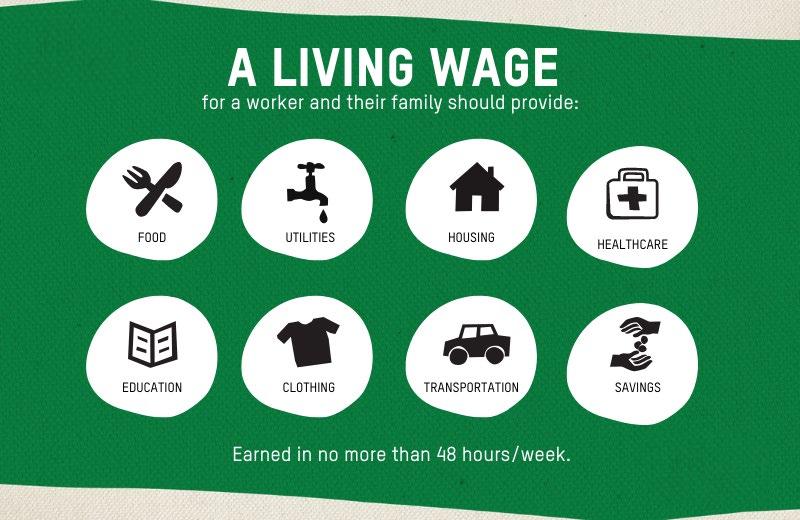
There are various ways to determine a living wage — the two key methods are the Asia Floor Wage and the Anker Methodology for Estimating a Living Wage. Both methods are credible, with the Asia Floor Wage usually higher due to differences in detail, approach and calculation. Companies should work towards these levels of pay and might see moving towards a living wage calculated using the Anker Methodology as an achievable first step.26 The Anker Methodology has been adopted by the Global Living Wage Coalition (GLWC.)27 It uses country- or area-specific data and demographics to determine the calorie requirements, family size and earning members in a family. This method gives more accurate data based on specific regions and industries of work, because it is calculated using costs from each region specifically where it is being applied. This paper refers to the GLWC living wage figures.
A living wage is not the same as minimum wage. As explained above, many countries are suppressing the minimum wage to be competitive in a global market. Minimum wage is defined as the minimum amount of remuneration that an employer is required to pay wage earners (workers) for the work performed during a given period, which cannot be reduced by collective agreement or an individual contract.28 However, as the following charts show, the minimum wage is often less than half of the living wage:
• In Bangladesh, minimum wage is 46% of the living wage.

• In Vietnam, minimum wage is 62% of the living wage




• In China, minimum wage is 52% of the living wage.
• In Cambodia, minimum wage is 74% of the living wage.
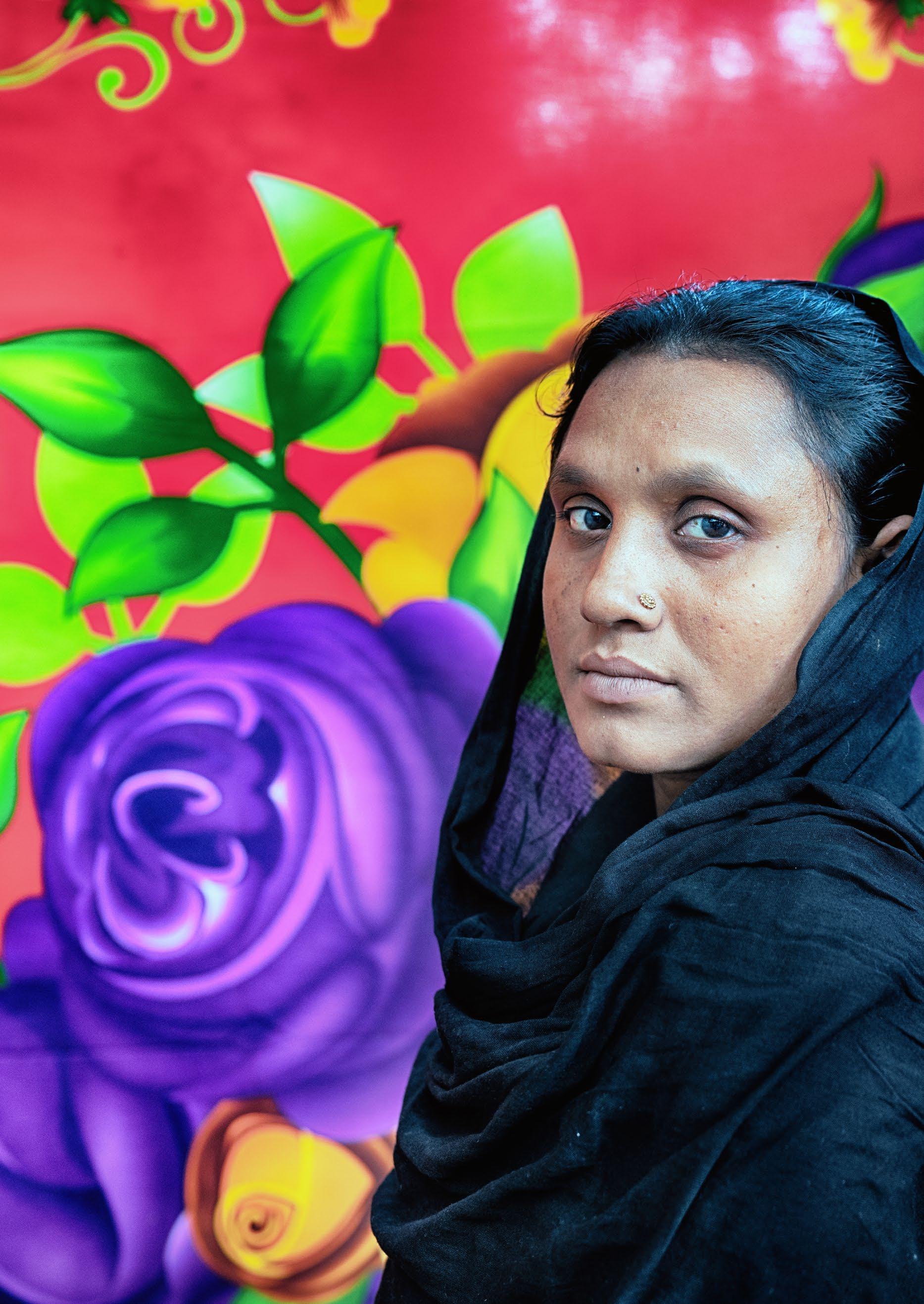
Being paid less than a living wage is a violation of an individual’s human rights.29 The Universal Declaration of Human Rights establishes the payment of a living wage as a human right (Article 23).30 The UN Guiding Principles on Business and Human Rights go further, clearly stating businesses’ role in and responsibilities to respect the human right to fair wages. This corporate responsibility “exists independently of States’ abilities and/ or willingness to fulfil their own human rights obligations… And it exists over and above compliance with national laws and regulations protecting human rights.”31 Therefore, in places where the legal minimum wage fails to meet the minimum subsistence level (i.e. a living wage) for workers — businesses have an obligation to remedy state failures. Even if states fail to pass minimum wage legislation at a rate that protects workers and ensures they can live with dignity, brands have a duty to ensure workers receive a living wage. A brand’s primary responsibility is not to comply with the wage law in the nation they choose to source from, but to ensure that the wages paid are enough to secure an existence worthy of human dignity for the worker.32
Paying a living wage is possible — research shows even if big brands passed the entire cost of paying a living wage on to consumers, it would increase the price of a piece of clothing by just 3–4%. That’s just 30 to 40 cents extra for a $10 T-shirt.33 However, if brands absorb the cost of paying a living wage within their supply chains, it will cost on average less than 1% of the retail price. Oxfam believes brands should change the way they do business to ensure workers are paid a living wage, rather than passing costs on to the people who buy clothes.

No major clothing brand in Canada has shown publicly that all workers making their clothing are being paid a living wage. Brands’ failure to ensure a living wage is paid in their supply chains means many thousands of the women who make clothes destined for Canadian stores live in poverty. Multi-million-dollar Canadian brands must use their power to end poverty.
Canada is one of the world’s major apparel markets, with retail sales totalling US$28.04bn in 2019. Like other developed nations, clothing sold in Canada is predominately imported. From 2015 to 2019 clothing retail sales grew around 1.1% annually. Excluding the drop in sales due to COVID-19, over the next five years, Canada’s apparel market is projected to continue to grow at a rate of 0.5–0.8% annually and could reach US$29.5bn.34
Asia is Canada’s top source of apparel, responsible for as much as 80% of imports. As China’s market share of total apparel imports declines (currently 36%), imports from Canada’s second and third largest suppliers, Bangladesh (12%) and Vietnam (10%), are growing.35 In 2019, Canada imported $1.8bn worth of clothing made in Bangladesh and $1.4bn made in Vietnam.36
What She Makes calls for a living wage to be paid across all source countries and we know Canadians care about how their clothing is made. A public opinion study of 600 Canadian consumers, commissioned by Oxfam Canada in 2019, reveals that 82% of consumers believe Canadian clothing brands should ensure a living wage and proper working conditions for the people who make and sell their clothes. While 72% mention that they would be willing to pay more, they tend to believe that the responsibility lay with Canadian brands to ensure
a living wage. A majority also believes Canadian brands could have significant positive impact on addressing all issues related to global supply chains if companies put the resources into real solutions.
Canadian brands make big money, and they must leverage that power to change the system and stop the exploitation of workers. They can be part of lifting women out of poverty while still producing affordable, good quality products. Brands have the power and the responsibility to ensure the workers who make their clothes can live decent lives and lift themselves and their families out of poverty.
Oxfam is calling on all Canadian brands to commit to ensuring the workers making their clothes are paid a living wage — and to publish a step-by-step strategy outlining how and when this will be achieved.
The primary asks of the Oxfam What She Makes campaign are focused on the long-term need for the payment of a living wage. Oxfam Canada’s runway to a living wage is based on three pillars:
1. Getting the basics right
2. Roadmap to a living wage
3. Paying a living wage
The progress of the brands will be tracked through the Brand Tracker on the What She Makes website. Within three months of the campaign launch date, Oxfam will publish a report card evaluating actions and practices brands have taken based on publicly available information. Oxfam is willing to help the brands in their journey to paying a living wage because we care about #WhatSheMakes.
To ensure that the women who make our clothes are being paid a living wage, brands should:
• Conduct a wage gap analysis
• Publish a responsible purchasing practices policy

• Develop and publish a roadmap to a living wage through a step-by-step strategy
To get the basics right, brands should:

• Make a credible commitment towards paying a living wage
• Be transparent and publicly disclose their supply chains on their websites
• Support supplier factories in establishing and implementing effective independent, grievance and remediation procedures
• Adopt a positive and proactive freedom of association policy to ensure supplier factories respect the workers’ rights to collective bargaining
• Adopt a positive and proactive gender and non-discrimination policy
Within four years of making the commitment, brands must pay a living wage within their supply chains, tier one, and ensure it goes directly to workers by establishing robust accountability mechanisms. What can the
» Enact new legislation mandating companies to identify and mitigate risks that may cause or contribute to human rights violations in their supply chain, in line with the OECD Due Diligence Guidance on Garments and UN Guiding Principles on Business and Human Rights.
» Brands enjoying a duty-free import of garment to Canada must ensure improved working conditions in global supply chains and move towards responsible purchasing practices.
» Collaborate with trade unions and labour rights advocates on educating companies about human rights responsibilities
» Collaborate with trading partners on global solutions to ending poverty wages
Canadians can stand in solidarity with the women who make our clothes and demand big brands pay a living wage. We all buy clothes, so we can use our voices to demand the brands we love do better. Brands care about what their customers think, so together, let’s use our power as people who buy clothes to demand Canadian brands pay a living wage. Uplift the work women are already doing to secure their rights in Bangladesh.
Visit to find out more: oxfam.ca/what-she-makes

 Fabeha Monir / Oxfam
Fabeha Monir / Oxfam
1 The conversion rate 1 Bangladesh taka = 0.01506 Canadian dollars (December 2020) has been used throughout the document.
2 Clean Clothes Campaign. (n.d.). Gender: Women workers mistreated. Retrieved 13 August 2021, from https:// cleanclothes.org/issues/gender
3 N. Kabeer and S. Mahmud. (2003). Globalization, gender and poverty: Bangladeshi women workers in export and local markets. Journal of International Development, 16(1), 93–109
4 M.R.I. Khan and C. Wichterich. (2015). Safety and labour conditions: the accord and the national tripartite plan of action for the garment industry of Bangladesh. International Labour Office. 113. Retrieved 13 August 2021, from https://www.academia.edu/17271190/ Safety_and_labour_conditions_the_accord_and_the_ national_tripartite_plan_of_action_for_the_garment_ industry_in_Bangladesh
5 S.N. Emran, J. Kyriacou and S. Rogan. (2019). Made in Poverty: The true price of fashion
6 Ibid.
7 Ibid.
8 ActionAid. (2019). ActionAid Briefing paper: Sexual harassment and violence against garment workers in Bangladesh. Retrieved 13 August 2021, from https://actionaid.org/publications/2019/sexualharassment-and-violence-against-garment-workersbangladesh#downloads
9 S.N. Emran, J. Kyriacou and S. Rogan. (2019). Made in Poverty: The true price of fashion
10 M. Anner. (2020). Abandoned? The impact of Covid-19 on Workers and Businesses at the bottom of global garment supply chains. Retrieved 13 August 2021, from https://www.researchgate.net/publication/340460592_ Abandoned_The_Impact_of_Covid-19_on_Workers_ and_Businesses_at_the_Bottom_of_Global_Garment_ Supply_Chains
11 M. Chen. ( 2020, July 7). Disaster Looms as the Coronavirus Disrupts the Garment Supply Chain. The Nation. Retrieved 13 August 2021, from https://www. thenation.com/article/economy/garment-supply-chaincoronavirus/
12 Ibid
13 M. Lawson et al. (2020). Time to Care: Unpaid and underpaid care work and the global inequality crisis. Retrieved 13 August 2021, from https://www.oxfam.org/ en/research/time-care
14 Based on publicly disclosed CEO compensation figures from Aritzia, Lululemon, Loblaw and Roots Canada, which paid on average $5.7mn in 2019 to their top-paid executives.
15 Oxfam. (2018). Reward Work, Not Wealth: To end the inequality crisis, we must build an economy for ordinary working people, not the rich and powerful. Retrieved 13 August 2021, from https://s3.amazonaws.com/oxfamus/www/static/media/files/bp-reward-work-notwealth-220118-en.pdf
16 ibid
17 S.N. Emran, J. Kyriacou and S. Rogan. (2019). Made in Poverty: The true price of fashion.
18 Minimum Wage — Textile. WageIndicator.org. Retrieved 13 August 2021, from https://wageindicator.org/salary/ minimum-wage/bangladesh/38599-textile
19 Ibid
20 Momota. (2020, August).
21 Clean Clothes Campaign. (n.d.). Frequently Asked Questions. Retrieved 13 August 2021, from https:// cleanclothes.org/faq/price
22 With new trends coming out every week, the fast fashion industry urges consumers to buy as many garments as possible, as quickly as possible. The constant inflow of low-cost, low-quality garments means we are buying and disposing of more clothing than ever. This has a real effect on the women working in the ready-made garment industry, with huge pressure to deliver on orders. What She Makes comes at a time when fast fashion has utterly changed the industry.
23 A. Bryher. (2019). Tailored Wages. Retrieved June 2019, from https://cleanclothes.org/file-repository/ tailoredwages-fp.pdf/view
24 Ibid.
25 J. Merk. (2014). A living wage in Asia. Amsterdam: Clean Clothes Campaign
26 S.N. Emran and J. Kyriacou. (2017). What She Makes: Power and poverty in the fashion industry. Retrieved 13 August 2021, from https://whatshemakes.oxfam.org. au/wp-content/uploads/2017/10/Living-Wage-MediaReport_WEB.pdf
27 The Anker Methodology for Estimating a Living Wage. Global Living Wage Coalition. Retrieved 13 August 2021, from https://www.globallivingwage.org/about/ankermethodology/
28 ILO Definition of Living Wage.
29 J. Merk. (2014). A living wage in Asia. Amsterdam: Clean Clothes Campaign
30 United Nations. (1948). Universal Declaration of Human Rights. Retrieved 13 August 2021, from https://www. un.org/en/about-us/universal-declaration-of-humanrights
31 Office of the High Commissioner of Human Rights. (2011). Guiding Principles on Business and Human Rights. Retrieved 13 August 2021, from https://www.ohchr.org/ Documents/Publications/GuidingPrinciplesBusinessHR_ EN.pdf
32 A. Bryher. (2019). Tailored Wages. Retrieved June 2019, from https://cleanclothes.org/file-repository/ tailoredwages-fp.pdf/view
33 Clean Clothes Campaign. (n.d.). Frequently Asked Questions. Retrieved 13 August 2021, from https:// cleanclothes.org/faq/price
34 M. DuBreuil and S. Lu. (2020). Canada’s clothing market — top selling and sourcing trends. Retrieved 13 August 2021, from https://www.just-style.com/analysis/ canadas-clothing-market-top-selling-and-sourcingtrends_id138505.aspx
35 Ibid
36 Trade Data Online. Retrieved from https://www.ic.gc.ca/ eic/site/tdo-dcd.nsf/eng/home
